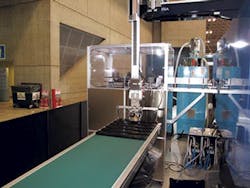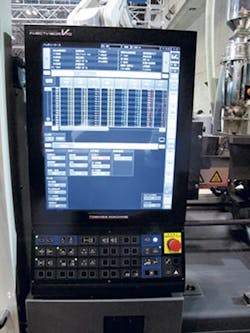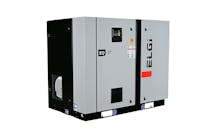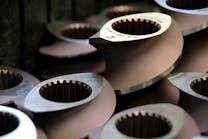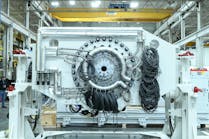New machinery and process developments that aim to replace metal parts with reinforced plastics in automotive and aerospace parts were a highlight at the triennial International Plastic Fair (IPF), held in Tokyo in October. While JSW showed off new ways to make reinforced parts, Toshiba presented a new take on foam injection molding; both companies plan to present the technologies at NPE2018.
JSW SHOWS NEW METHODS TO MOLD REINFORCED PARTS
JSW unveiled two new approaches to producing high-strength, rigid parts on a standard injection molding machine using standard resins. The first involves the incorporation of a unidirectional tape made of carbon fiber, and the second uses blending and feeding equipment to add the reinforcement at the feed throat. With the methods, JSW rethinks how a reinforcing material such as carbon fiber or glass fiber can be added to enhance part strength without the need for a special press.
In the first approach, a carbon-fiber tape is added to the mold prior to molding. The tape can increase part rigidity by at least 10 times, said David Lyons, JSW sales engineer and territory manager.
During IPF, JSW demonstrated the method, in which automation equipment transfers the tape to the core and cavity of a mold, forming the outer skin of the molded part. A user also can apply the tape to specific areas of the part, if desired. The tape assumes the contours of the mold during injection and can be shaped in any dimension. It does not require preheating or any special handling, Lyons said.
The tape is a recent development from Toray Industries Inc., Tokyo, an international supplier of high-performance films, plastics, carbon fiber and synthetic textiles.
According to Lyons, who worked with Toray on the project, the tape is composed of up to 60 percent carbon fiber, with the remainder the same resin used for the part. Matching the resin in the tape to the resin used to mold the part ensures a permanent bond. Toray has patents on the tape impregnation process, which is commercially available, Lyons said. The tape can be made to any desired thickness, width or length, and can be made in a variety of resin types.
Toray and JSW designed a new tape reel machine for unwinding the tape that is incorporated into the manufacturing cell but is controlled independently. When the injection molding machine sends a signal, a length of tape is unspooled from the reel, and the automation equipment advances and positions the tape in the open mold.
The mold was specially designed for the show demonstration by a Japanese mold builder and features an electric cutter that slices the tape as the mold closes.
During IPF, JSW used the technique to produce a curved part made from nylon 6. The tape used was 0.3mm thick and about 3 inches wide.
The part was molded in a J280ADS-890H-CFRTP/UD-Tape injection molding cell in a single-cavity mold with a cycle time of 48 seconds, said Joseph Lombardo, assistant sales manager for Japanese accounts.
"The primary benefit of this approach is that the molder can use a standard injection molding machine and standard resins to produce a high-strength, highly rigid part," Lyons said.JSW's second approach to producing a carbon- fiber-reinforced part is called Reinforced Fiber On-line Blending Molding.
The capability is based on two new developments. The first is an electrically driven, loss-in-weight blender system designed by JSW that receives the resin and the reinforcement material. The independently controlled system features sensors and a high-precision scale that measures and mixes the material, then discharges it to the feed throat of the injection unit. Electric motors control the amount of each material entering the mixing chamber. The system lets an operator adjust the percentage of reinforcement material — up to 60 percent of the formulation by weight.
Combining the raw materials at the machine eliminates the need to purchase a higher-priced premixed formulation and allows the operator to dial in the exact amount of reinforcement required. Molders can vary the percentage of the reinforcing material on the fly, if needed, said Robert Columbus, marketing and regional sales manager for the Eastern region of the U.S.
The second development is a new screw and barrel design for an injection molding machine that was created to optimize processing of the material. An injection molding machine with a 40mm-diameter screw with a 27:1 L:D ratio is used with the in-line blending equipment. During IPF, JSW molded a demonstration part from a 30-percent carbon-fiber-filled nylon 6 on a J100ADS-180U electric molding machine.
TOSHIBA MACHINES ADVANCE TWO LIGHTWEIGHTING APPROACHES
Toshiba unveiled a new line of presses and a new machine controller. The company also molded reinforced parts and showed a new approach to foam injection with toggle machines.
The company unveiled the EC-SXIII, its latest generation of all-electric injection molding machines. This line eventually will replace the EC-SXII series that was launched in 2014 and comprises 15 models with clamping tonnages ranging from about 33 tons to 1,950 tons, said Michael Werner, senior technical key account manager for the plastics machinery division.
The EC-SXIII models feature Toshiba's new Injectvisor V70 machine controller, which replaces the V50 controller and has increased memory, updated graphics and enhanced customizable settings and configurable machine sequences.
The controller, which has a 19-inch color touch screen, incorporates software that is more freely programmable and can be used to control a wider array of peripheral equipment, the company said.
The Injectvisor V70 controller provides enhanced capabilities, such as improved cycle-time analysis and easy programming for complex techniques such as core-back sequences. Users can reconfigure a program sequence using touch and drag movements, Werner said.
At its IPF booth, Toshiba demonstrated a range of capabilities on five EC-SXIII models. The demonstrations included smart-factory applications and two-shot molding, as well as a new adapter plate that allows for injection units in a greater range of sizes to be attached to a clamping unit. The company also highlighted molding with reinforced materials and foam injection molding.
Toshiba used an EC180SXIII model to mold a part from carbon-fiber-reinforced polyamide 66. Previously, the part had been made of metal. The molding machine was part of a production cell making a 330-gram part in a cycle time of 60 seconds, which compares to a 660-gram part made from aluminum. Approximately 35 seconds of the total cycle time is dedicated to heating the sheet to 572 degrees Fahrenheit, Werner said.
Two TV1000 six-axis robots from Toshiba's automation division handled the part, a thermoplastic sheet impregnated with carbon fiber. One six-axis robot pulled the sheet from a tray and introduced it to a special press-side oven for heating and forming, while a second robot handled sheet loading into the mold and part takeout. The reinforced sheet was overmolded with a polyamide 66 that was 30-percent filled with carbon fiber and formed the ribs and bosses of the part.
Toshiba also demonstrated a new foam injection molding method made possible by the new EC-SXIII line, Injectvisor V70 controller, a gas-generation device and a special software program. These technologies improve the ability of an all-electric molding machine with a toggle clamp to precisely and repeatedly mold foamed parts.
Toshiba demonstrated the new foam injection method on an EC650SXIII-26BP, a two-stage machine featuring a continuous extruder and a plunger-type injection unit. The machine's 80mm-diameter screw fed a plunger injection screw that moved material into the mold.
A special nitrogen-gas generator designed by Toshiba, in combination with a special software program developed and run on the Injectvisor V70, synchronized nitrogen introduction and the physical foaming of the part with the movement of the toggle clamp. Toshiba integrated two hydraulic cylinders into the injection press that assisted in the movement and positioning of the toggle linkages. The hydraulic cylinders provide a core-back function for the tool while minimizing spacing between the linkages, which improves clamp movements during foaming, Werner said. The tooling for the foam injection molding, from a Japanese mold maker, is designed so that any openings in the part are surrounded by solid plastic, not foam.
Mikell Knights, senior staff reporter
mknights@plasticsmachinerymagazine.com
For more information
JSW Plastic Machinery Inc.,Lake Zurich, Ill., 847-550-0740, www.jswpmi.com
Toshiba Machine Co. America,Elk Grove Village, Ill., 847-709-7000, www.toshiba-machine.com

